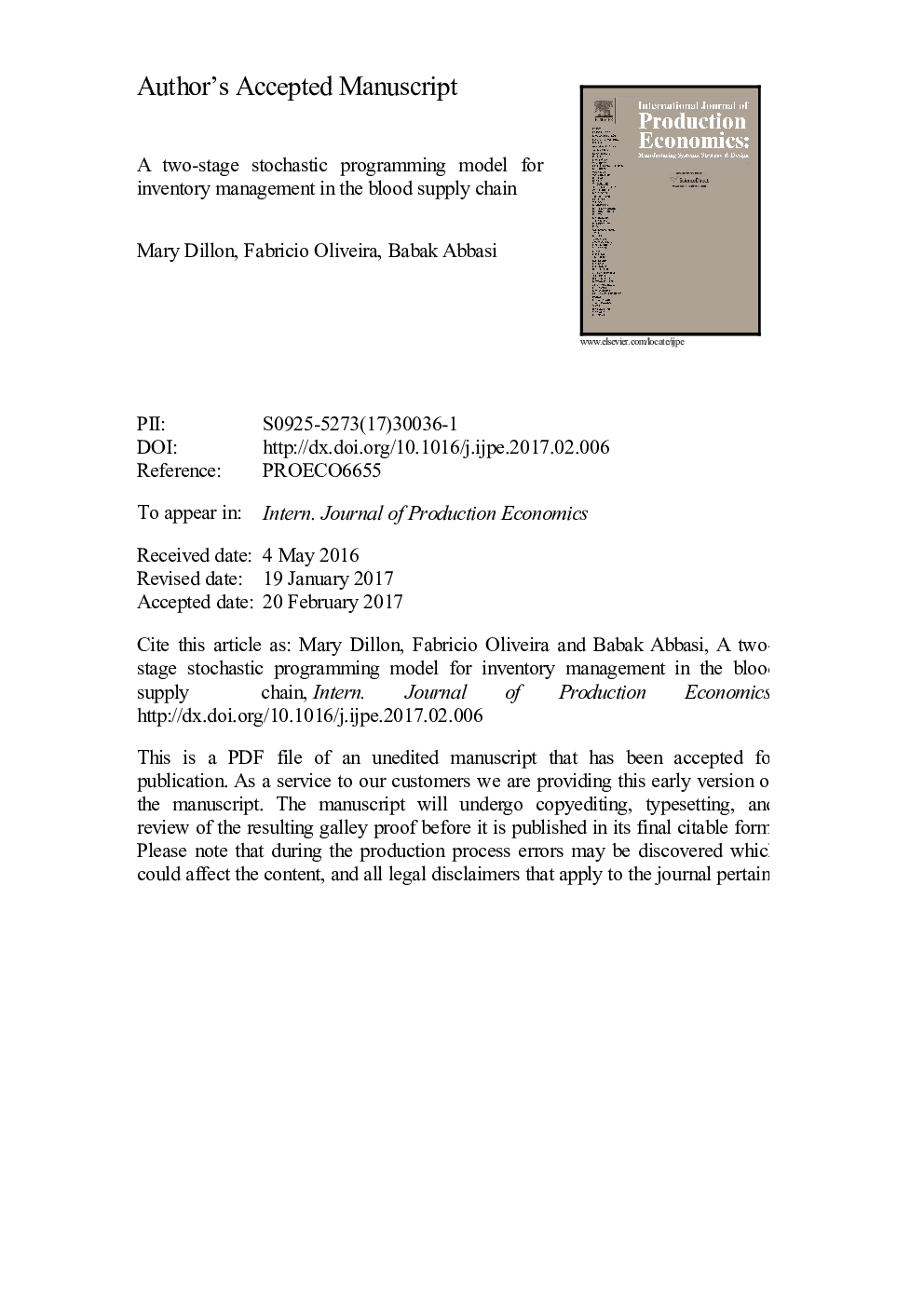| کد مقاله | کد نشریه | سال انتشار | مقاله انگلیسی | نسخه تمام متن |
|---|---|---|---|---|
| 5078948 | 1477517 | 2017 | 66 صفحه PDF | دانلود رایگان |
عنوان انگلیسی مقاله ISI
A two-stage stochastic programming model for inventory management in the blood supply chain
ترجمه فارسی عنوان
یک مدل برنامه ریزی تصادفی دو مرحله ای برای مدیریت موجودی در زنجیره تامین خون
دانلود مقاله + سفارش ترجمه
دانلود مقاله ISI انگلیسی
رایگان برای ایرانیان
کلمات کلیدی
MILPBSCADPTwo-stage stochastic programming - برنامه ریزی تصادفی دو مرحله ایmixed-integer linear programming - برنامه ریزی خطی مخلوط عددیInteger programming - برنامه ریزی عدد صحیحLinear programming - برنامهریزی خطیDynamic programming - برنامهریزی پویا یا برنامه نویسی پویاStochastic demand - تقاضای تقریبیApproximate dynamic programming - تقریبا برنامه نویسی پویاBlood Supply Chain - زنجیره تامین خونPerishability - فاسد شدنInventory management - مدیریت موجودی
ترجمه چکیده
مدیریت موجودی در زنجیره تامین یک کار چالش برانگیز است، که عمدتا به دلیل ماهیت تقصیر تقاضا برای واحد های خون، ماهیت فاسد شدن خون و تعصب شدید ذهنی نسبت به معیارهای غیر از کاهش هزینه است. در این مقاله، ما یک مدل برنامه ریزی تصادفی دو مرحله ای برای تعریف سیاست های بازنگری بهینه دوره ای برای مدیریت موجودی گلبول های قرمز پیشنهاد می کنیم که بر کاهش هزینه های عملیاتی، و همچنین کمبود خون و تلفات ناشی از بی نظمی، با توجه به فرسودگی پذیری و عدم اطمینان تقاضا، تمرکز دارد. . اتخاذ این چارچوب به بررسی فرآیندهای تصدیق عمومی می پردازد تا عدم قطعیت تقاضا را نسبت به روش های موجود در ادبیات مدل کند. علاوه بر این، این چارچوب، یک مدل را ارائه می دهد که می تواند به طور کارآمد با نرم افزار بهینه سازی مطلوب به طور کلی حل شود. برای نشان دادن مزایای بالقوه اتخاذ مدل پیشنهاد شده برای حمایت از تعریف سیاست های کنترل بهینه موجودی خون، مطالعه موردی با توجه به داده های واقع گرایانه نشان دهنده تقاضای روزانه خون است که با استفاده از میانگین و انحراف معیار تقاضا برای هشت انواع خون نتایج نشان می دهد بینش قابل توجه در مورد شیوه هایی که می تواند منجر به بهبود عملکرد زنجیره تامین شود. به طور خاص، ما مشاهده کردیم که می توان از طریق کاهش سطوح هدف فعلی برای کاهش هزینه ها و هزینه های کل بدون به خطر افتادن سطح خدمات، امکان تغییر سیاست های موجود موجودی وجود داشته باشد. در نهایت، بررسی جایگزینی خون بهبود عملکرد سیستم مدیریت موجودی خون را بهبود بخشید.
موضوعات مرتبط
مهندسی و علوم پایه
سایر رشته های مهندسی
مهندسی صنعتی و تولید
چکیده انگلیسی
Managing inventories in the blood supply chain is a challenging task, mainly due to the uncertain nature of the demand for blood units, the perishable nature of the blood, and a strong subjective bias towards criteria other than cost minimisation. In this paper, we propose a two-stage stochastic programming model for defining optimal periodic review policies for red blood cells inventory management that focus on minimising operational costs, as well as blood shortage and wastage due to outdating, taking into account perishability and demand uncertainty. The adoption of this framework allows the consideration of more general stochastic processes to model the demand uncertainty than approaches currently available in literature. Moreover, this framework renders a model that can be solved efficiently by general purpose off-the-shelf optimisation software. To illustrate the potential benefits of adopting the proposed model to support the definition of optimal blood inventory control policies, a case study is presented considering realistic data representing the daily demand for blood, which was generated using the average and standard deviation of the demand for eight types of blood. Results suggest meaningful insights concerning practices that could lead to improvement in the blood supply chain performance. In particular, we observed that it would be possible to revise the current inventory control policies by reducing current target levels to diminish wastage and total cost without compromising the service level. Finally, the consideration of blood substitutions showed further improvement in the performance of the blood inventory management system.
ناشر
Database: Elsevier - ScienceDirect (ساینس دایرکت)
Journal: International Journal of Production Economics - Volume 187, May 2017, Pages 27-41
Journal: International Journal of Production Economics - Volume 187, May 2017, Pages 27-41
نویسندگان
Mary Dillon, Fabricio Oliveira, Babak Abbasi,
